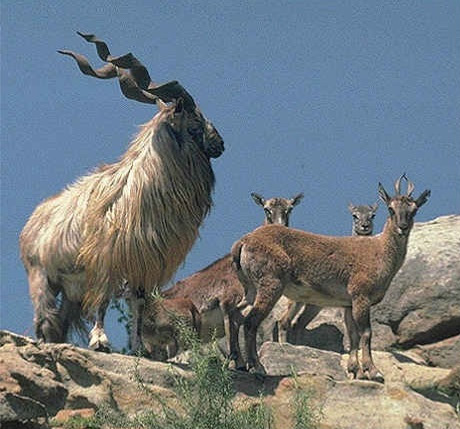


Local name: Goral (Urdu)
Description and Biology:
Size:Body Length: 95-130 cm / 37-53 in.
Shoulder Height: 75-80 cm / 30-32 in.
Tail Length: Up to 18 cm / 7.2 in.
Weight: 35-42 kg / 77-92 lb.
Description: The Goral is considered to be a “goat-elope”, sharing characteristics of both the true goats and sheep, and antelope. The coat varies in colour from grizzled grey to gray-brown, and grows shaggy in winter. The slender legs are light tan in colour, and there is a lighter coloured ‘bib’ at the base of throat. A dark stripe extends dowe the spine and onto the forelegs. The back is slightly arched, and the facial profile is concave. Males have a short, semi-erect mane. Both sexes have short, pointed horns which curve backwards. With small, irregular ridges, they grow 13-18 cm / 5-7 inches long.
Biology: Breeding may take place at any time of the year; however, bucks are more active in spring and fall. Fawns are born at all seasons, but fewest births occur in winter. The length of gestation is about 5 months and within a month of parturition the female may breed again. A single fawn is the rule. Females reach sexual maturity by 8 months of age, but usually do not breed until nearly 2 years of age. Physical maturity is reached at 1 year. Males mature later than females, and are able to breed at 18 month of age. The lifespan is up to 15 years.
Reproduction: Gestation Period: 170-218 days. Young per Birth: 1, rarely up to 3. Weaning: At 7-8 months. Sexual Maturity: About 3 years. Life span: 14-15 years.
Social Behaviour: Gorals are most active in the early morning and late evening, but on cloudy days roam throughout the day.They often drink after eating in the morning, thereafter retiring to a rock ledge on which to rest until evening. Gorals are extremely nimble, and can move at high speeds across inaccessible terrain. Their remarkable camouflage is extremely effective, and along with the fact that they lie motionless, gorals are extremely difficult to spot, even when in plain site. The alarm call consists of hissing or a sneezing noise. Groups inhabit an area of about 100 acres. During the mating season, males may occupy and mark territories of 22-25 hectares. Old males are usually solitary, otherwise they live in small groups of 4-12.
Diet: leaves, twigs, nuts. A study was conducted on grey goral (Nemorhaedus goral )by Maqsood Anwar and Joseph A. Chapman of the Pakistan Agricultural Research Council for its feeding habits and food in the Margalla Hills National Park. Goral mostly foraged early in the morning at sunrise and late in the evening before sunset (75%). Their major food consisted of leaves of certain trees and shrubs when green grass was not available. They changed their foraging activities almost entirely to grazing on green grass during the spring and summer. Vegetation analysis of goral habitat revealed that about 60% of the vegetation consisted of plant species commonly eaten by goral. These species included Themeda anathera, Chrysopogon aucheri, Carissa opaca, Acacia modesta, Mimosa rubicaulis and Ipomoea hispida. Clumps of chir pine (Pinus roxburghii) were found on higher ridges with scattered grasses and shrubs as understorey cover. Vegetation cover comprised 47.1% grasses, 33.4% shrubs and 19.5% trees. The frequency occurrence of grasses, shrubs and trees was 81.5%, 14.5% and 4.0%, respectively. Total ground cover was almost the same on both the northern and southern slopes. Livestock competed with goral for forage in most of its habit area.( all above information from “The Ultimate Ungulate Page” by Brent Huffman and FEEDING HABITS AND FOOD OF GREY GORAL IN THE MARGALLA HILLS NATIONAL PARK, April-June, 2000, Vol. 16 No.2 of Pakistan Journal of Agricultural Research Council ).
Habitat and Distribution:
Gorals inhabit wooded mountain slopes at elevations of 1,000-4,000 m /3,300-13,500 ft in the Himalayas. In Pakistan the Goral is mainly found in the Margalla National Park. Small Populations are found futher west in Swat, Dir and lower Chitral. The Goral is rare in Chitral.The main surviving population of Goral is in Margalla Hills National Park. The population has increased, but is still very local and small. A study on grey goral (Nemorhaedus goral) was conducted by Maqsood Anwar and Joseph A. Chapman of the Pakistan Agricultural Research Council in the Margalla Hills National Park (MHNP) to determine its distribution and population status. They were confined to the steep slopes and difficult terrain. They were usually found very close to the ridges. Presently, 28% of total park area is occupied by goral and 21% of the park area has similar habitat, but without any goral occurrence there. Among 40-60 animals living in the park, it was observed that 72% were adults and 28% were juveniles. Juveniles were accompanied by adults on 80% occasions and sex ratio was near 1:1. ( T.J Roberts Mammals of Pakistan and “DISTRIBUTION AND POPULATION STATUS OF GREY GORAL IN THE MARGALLA HILLS NATIONAL PARK”, April-June, 2000, Vol. 16 No.2 of Pakistan Journal of Agricultural Research Council).
